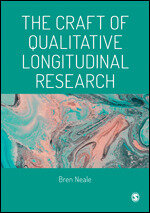Researching Lives Qualitatively through Time: Broadening the Evidence
In May 2021 we focused on Finding Data in Documents and Datasets. Guest contributor Bren Neale, author of the new SAGE book, The Craft of Qualitative Longitudinal Research, discusses the use of multiple sources of evidence when conducting a study over a period of time.
The first blog post in this series highlighted the typically small scale, intensive and situated nature of QL enquiry, its capacity to create an intimate movie of unfolding lives. Stand-alone studies of this nature have value in their own right. But Qualitative Longitudinal (QL) research can also be used to create a broader vision of unfolding lives, by extending the reach of a study through time or space, or linking to a larger scale of enquiry. In effect, this creates a third kind of movie, intimate epics, which allow for qualitative generalisations to be made, yet do not compromise on the depth and explanatory power of QL enquiry. Varied ways of designing QL studies to create a broader vision are outlined here. These strategies may be used separately or in combination.
Extensive QL studies/Re-studies
QL researchers commonly revisit their participants over the longer-term, thereby extending the longitudinal reach of an intensive study. They are often motivated by an abiding concern to know what has happened to the people who have shared their life stories, to understand the next instalment in a never ending story. This is in a context where the future is essentially unpredictable and the causes and consequences of change need to be pieced together in retrospect. Extending a QL study in this way generates important insights into longer term outcomes, how trajectories unfold over the life course, and how biographical and historical processes intersect.
In the tradition of longitudinal ethnography, researchers may return over many decades to the same participants. Classic examples include Laub and Sampson’s (2003) study of delinquent ‘boys’ in the USA, who were followed up at the age of 70, and Williamson’s longitudinal ethnography of the Milltown Boys, a group of impoverished teenagers in Wales, who were followed through three phases of fieldwork spanning 50 years (Williamson 2004; 2021). It is increasingly common for researchers to extend the reach of their studies in this way, although this usually relies on securing more funding, and requires researchers to maintain contact with participants, or to re-trace them if contact has been lost.
Network Projects/Qualitative Panel Studies
These studies create a broader picture by working with larger and more stratified samples, across a broader range of settings, over more extensive time frames, and with larger teams or networks of researchers. The national level Timescapes Initiative (Neale, ESRC 2007-12) was built on a network model. It brought together seven empirical projects that explored the changing lives of over 400 families across the generations (www.timescapes.leeds.ac.uk;www.timescapes-archive.leeds.ac.uk).
The QL Family-Work project explored the family fortunes and employment journeys of lone mothers and their children over time. The study was initially conducted through three waves of in-depth interviews that tracked the families over a four to five-year period. A follow up study, conducted a decade later, yielded new insights into the unfolding trajectories of the families, and enabled the researchers to uncover the significant impact of income insecurity on the longer-term fortunes of the families. By the time of the final round it was continuity rather than change that was the most striking. The women had mainly stayed in work… But many were still on wages at, or not much above the minimum wage. This had major implications for their futures and their capacity to help and support their children into adulthood. There is often limited capacity to help and support their children into adulthood. There is often limited capacity to effect a significant and lasting improvement in income and material circumstances over longer periods of time. For the children, the impact of financial insecurity could cast long shadows. (Millar 2020: 3,5)
Network studies such as these can target a broader, more comprehensive and strategically chosen range of cases across varied settings of change. One of the challenges of creating a broader evidence base is to ensure harmonisation of data across the projects, to enable analytical connections and comparisons across cases and through time. Suites of common questions and continuity questions provide useful through lines in the data to address this requirement, while still allowing for data on the particularities of individual journeys.
Mixed Longitudinal Studies
QL studies are increasingly nested within or otherwise linked to larger-scale longitudinal studies. This creates valuable iteration between complementary scales of enquiry, with harmonisation of samples, research questions and data collection to aid analysis. In a nested study, a sub-sample of participants from a large panel can be drawn into a QL panel and followed more intensively over time (e.g. Wenger’s (1999) study of the vulnerabilities and support needs of older people in rural Wales).
In these mixed longitudinal designs, anomalies and puzzles in the larger-scale dataset can be explored in-depth through the qualitative panel, and insights fed back into the next wave of the larger study. Alternatively, separate samples may be recruited and linked through the harmonisation of research questions and data. This creates complementary data for analysis. Examples of linked studies include Burton et al’s (2009) five-year longitudinal ethnography of 256 low-income families in the US, which was linked to a large-scale longitudinal survey of 2,402 fragile families across three states; and a global study of child poverty conducted across three continents (Morrow and Crivello 2015).
Qualitative Synthesis: Building a Mosaic of Existing Evidence
A final strategy involves building a mosaic of evidence from existing research findings and/or a re-analysis of existing datasets (made possible through a growing infrastructure of data repositories, such as the Timescapes Archive, and advances in data sharing and analysis (Hughes and Tarrant 2020)). Causality can be established here in new ways: through the elaboration and synthesis of multiple empirical examples, drawn from a strategically chosen range of pre-existing cases. Unlike a meta-analysis, which works with strictly comparable statistical data, a qualitative synthesis weaves complementary forms of data and evidence, (qualitative/ quantitative, local/global, historical/contemporary, expert/lay knowledge) into a composite whole. With the accumulation of real-world data and evidence the overall picture is continually refined. Insights into patterns and processes of change are given added credence through the extent, variety and weight of the empirical evidence. This approach has been used recently in the collaborative analysis of welfare conditionality (Wright and Patrick 2019) and energy poverty (Middlemiss et al 2019).
This brief overview has explored the scope for combining varied forms of data and evidence, gathered across different times, places and scales of the social fabric, that tell us very different but complementary stories about unfolding lives. The creative designs outlined above testify to the increased sophistication in the way that QL researchers are combining depth and breadth, or intimate and epic movies, to produce a broader vision of dynamic processes.
Burton, L., Purvin, D. and Garrett-Peters, R. (2009) ‘Longitudinal ethnography:
Uncovering domestic abuse in low income women’s lives’, In G. Elder and J. Giele (eds) The Craft of Life Course Research. New York: Guilford Press. pp. 70-92.
Dwyer, P. (2018) Final Findings Report: Welfare Conditionality Project. York: Department of Social Policy and Social Work. www.welfareconditionality.ac.uk
Hughes, K. & Tarrant, A. (eds) (2020) Qualitative Secondary Analysis. London: Sage.
Laub, J. and Sampson, R. (2003) Shared Beginnings, Divergent Lives: Delinquent Boys to Age 70. Cambridge, Mass: Harvard University Press.
Middlemiss, L., Ambrosio-Albalá, P., Emmel, N., Gillard, R., Gilbertson, J. et al (2019) ‘Energy poverty and social relations: A capabilities approach’, Energy Research and Social Science, 55: 227-235.
Millar, J. (2020) ‘Families, work and care over time: Reflections on a qualitative longitudinal study’, Social Policy and Society online.
Morrow, V. and Crivello, G. (1915) ‘What is the value of qualitative longitudinal research with children and young people for international development?’ International Journal of Social Research Methodology, 18 (3): 267- 280.
Wenger, C.(1999)’Advantages gained by combining qualitative and quantitative data in a longitudinal study’, Journal of Aging Studies, 13 (4): 369-76.
Williamson, H. (2004) The Milltown Boys Revisited. Oxford: Berg.
Williamson, H. (2021) The Milltown Boys aged 60: The Origins and Destinations of Young Men from a Poor Neighbourhood. London: Routledge.
Wright, S. and Patrick, R. (2019) ‘Welfare conditionality in lived experience: Aggregating qualitative longitudinal research’, Social Policy and Society, 18 (4): 597-613.
















Learn about qualitative data analysis approaches for narrative and diary research in these open access articles.